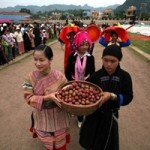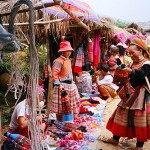Diverse tropical ecosystems of Halong Bay
Halong Bay’s Aesthetic Value
The permanent beauty of Ha Long is created by three factors: stone, water and sky. Ha Long’s island system is multicolored with a variety of shapes and can be regarded as a water-color, a work of art. The islands, scattered all round, have different shapes which provoke the imagination: Dinh Huong (Incense Burner) implies spiritual significance, Ga Choi (Fighting Cocks) the symbol of Viet Nam tourism, Con Coc (Toad) recalls the passage of time, waiting thousands of years to seek justice in Heaven. There are islands that resemble a resplendent throne, a Vietnamese mother’s curved back carrying her child, a roof, an old man, a human head and so on.
Within the bigger islands are great attractions. Dau Go Cave (Wooden Stakes) dazzles the senses with many huge stalactites hanging poised in mid air and stalagmites growing majestically upwards. Then there is Thien Cung Grotto (Heavenly Palace) with its small, narrow entrance, but inside looking like a marvelous palace, and many other caves each has its own attractions and beauty.
Ha Long’s sea is always the same, blue, smooth and still. Ha Long has its own beauty by seasons. In Spring, buds of trees burst on limestone islands. In Summer, it is cool and clean with many sparkling sun rays reflecting from the sea’s surface. In Autumn, especially at night, moonlight illuminates the mountains so they appear like gold, inlaid into the earth. In Winter, with pervasive frost, Ha Long is glamorous as “a floating flower basket on smooth wave”.
Geological value
Halong Bay’s geological value has been evaluated in two ways: by the history of its formation and by its karst geomorphology.
Formation history: The Halong Bay area has a long geological history, commencing nearly 500 million years ago, stretching through various ancient geological periods involving the processes of orogeny earth movements, marine regression, tectonic down-warping and marine transgression. Between the Ordovician and Silurian periods (500 to 410 million years ago) the area was a deep sea. Later, between the Carboniferous and Permian periods (340 to 250 million years ago) the sea had become shallow. By the end of the Paleogenic and the beginning of the Neogenic periods (26 and 20 million years ago) the area had become part of a great coastal plain. This was inundated again by the sea about 2 million years ago. During the Triassic period, (240 and 195 million years ago) when most of the rest of the world was experiencing hot, dry climatic conditions, the Ha Long region had a hot and wet climate. The decayed remains of enormous forests of tree ferns were the basis of the coal deposits in the area.
– Karst geomorphologic value: Ha Long Bay is a mature karst landscape developed during a warm, wet, tropical climate. The sequence of stages in the evolution of a karst landscape over a period of 20 million years requires a combination of several distinct elements including massive thickness of limestone, a hot wet climate and slow overall tectonic uplift. There are various stages of karst formation and remnants of old phreatic, old karstic foot and marine notch caves can be observed. The characteristics of mature karst terrain are Fengling and Fengcong. The conical shapes of fengcong karst form clusters of limestone, having pyramid shapes lying close together with an average height of around 100m, though the highest may reach up to 200m. The conical shapes of fenglin karst are like individual towers having abrupt slopes and reaching heights of between 50 – 100m. The ratio between height and width is 6:1. Conical shapes of fengcong karst can be seen in the groups of hills on Bo Hon and Dau Be islands. The karst fields were formed in different ways, such as: landslide, ceiling collapse of underground river valleys and underground caves ,and by the existence of undissolved stone layers. These karst fields were regularly flooded by the sea.
The underground karst topography is divided into 3 main types of caves:
+ Remnants of old phreatic caves such as Sung Sot, Tam Cung, Lau Dai, Thien Cung, Dau Go and Thien Long.
+ Old karstic foot caves such as Trinh Nu, Bo Nau, Tien Ong and Trong;
+ Marine notch caves such as Luon Cave, Ba Hang and Ba Ham Lakes.
The karst landscape of Ha Long Bay is of international significance and of fundamental importance to the science of geomorphology. The geology of Ha Long Bay is associated with the value of its bio-diversity, archaeological culture, history and other significant values.
The Cultural − Historical value
The physical beauty of Ha Long Bay consists of its mountains, water, clouds, caves and grottoes. Many, however, do not realise that Hạ Long was also the cradle of an ancient people who helped create the present Hạ Long culture.
At the end of 1937, a Swedish archaeologist named Anderson, together with two French archaeologist sisters named Conani, journeyed for months through Ha Long sea. They climbed mountains, visited caves and explored the coastline, finding many stone artifacts including axes, grinding tables, sewing needles and jewelry. The archaeologists named the culture that formed these remnants “Ngoc Vung”. In the years following this initial exploration, Vietnamese archaeologists continued the research and made many new excavations, discovering more archaeological sites, such as Dong Mang, Xich Tho and Soi Nhụ. Through an area of some hundreds of square kilometers, they discovered many stone artifacts and pieces of broken pottery.
Throughout its development, Ha Long has had a particularly significant position because of its location on the important communication and trade routes between China, Japan and Thailand. Gradually, it became the center of cultural and commercial exchanges between these countries and ancient Vietnam. The book Comprehensive History of Dai Viet reads: “In the second month of the spring of the year of Ky Ty, the 10th year of the reign of Ly Anh Tong (1149), the commercial port of Van Don was established.” In the long period overlapping the Ly, Tran and Le dynasties, Van Don was a place of busy commercial and cultural exchanges between Vietnam and its Southeast Asian neighbours. A remaining vestige of the ancient commercial port is Cai Lang Wharf (Quan Lan).
Van Don is also a site that witnessed glorious feats of war against the invasion of Yuan-Mongol warriors . It was here that the enemy leader, General Truong Ho, had an entire fleet of food supply boats set ablaze by Tran Khanh Du. This contributed greatly to the victory of Bach Dang.
Closely linked to this animated commercial centre were many religious architectural constructions built to meet the requirements of both traders and the population that practised Catholicism and Buddhism.
In particular, in the central zone of the present UNESCO World Heritage Site area, there have recently been fascinating archaeological discoveries at Me Cung, Thien Long and Tien ong grottoes. The quantity of ancient shellfish in the Melina Spring, which form 1.5 m-thick heaps of shells, amounts to hundreds of cubic metres of human activity.
The archaeological sites of the Ha Long culture are distributed everywhere, but are mostly found on the sandy beaches of the coastline, and in these caves and grottoes: Ngoc Vung, Tuan Chau, Xich Tho and Dong Mang. There are also sites far from the coast, such as Thoi Gieng and Tien ong. Wherever the remnants of the first peoples of Hạ Long are found, they seem to bear a common characteristic: the use of the same materials, techniques, forms and designs. Scientists have called it the “Ha Long culture of the late period of the new Stone Age.”
At Cai Lang Wharf, along its 200m-long coastline, scientists have found broken pieces of pottery and china forming a 0.6 m-thick layer. Ages of the artifacts date from between the Ly and Tran dynasties. Also found in the area are the foundations of ancient houses once built along the wharf. In other areas, such as Cong Dong, Cong Yen, Ngoc Vung, Quan Lan and Cai bau, more ancient wharves have been found, along with many similar artifacts.
On Cong Dong Island, four pagodas were built. Among them, the Lam Pagoda is one of the most ancient in the area. It was built under the Tran Dynasty with three gates, a shrine to Buddha, an anterior cult room and a house of ancestors. On the northeast side of the pagoda was a tower, the remnants of which indicate it was a large construction with religious importance.
The biodiversity value
Research results show that Ha Long Bay is filled with diverse tropical ecosystems including coastal mangrove habitat, coral reefs, sea grass habitat and tropical tree forests.
The topography of Ha Long Bay has a very complex structure because the coast includes many large estuaries which provide an important and abundant nursery and food source for many species of marine creatures and the thousands of islands create additional coastline and many bays. Relatively stable water levels (the tidal change is not large), small waves, and the stable climate of Ha Long. (Average temperatures from 19 – 25 ° C) provide conditions very favorable for these naturally stable ecosystems.
Scattered throughout Ha Long Bay are lovely coral reefs often found at a depth of 4 – 6 meters, with a particular concentration near the eastern and southern shores. According to marine scientists, there are 163 species of corals in the bay which form disks, tree-shapes, and underwater gardens of many colors. The coral reefs create a vibrant habitat for as many as 107 species of fish, as well as seaweed, crustaceans, and microscopic marine creatures.
In addition to the coral reefs, one can find mangrove forests in many of the coastal areas of Halong Bay, particularly near Tuan Chau, Cua Luc, and Ba Che. The Quang Ninh area is home to many varieties of mangrove trees most abundant in northern Vietnam. Mangrove forests create a unique landscape of fascinating intertidal life including fish, crustaceans, and shellfish and also support a variety of migrating birds.
Besides the two ecosystems mentioned above, Ha Long Bay has abundant tropical forests with many species of trees and plants. The forest ecosystems house rare wild animals such as deer, mink, squirrels, and monkeys.
Ha Long Bay also supports a number of fish-farms which supply seafood to the rest of Vietnam and other countries. Marine biologists and their students study the ecology of the area and help develop markets for the farmed sea grass, seaweed, algae, fish and shrimp. Farther offshore, where populations of shrimp, fish, squid, abalone, and other sea life exist, thousands of tons of food are caught annually.








